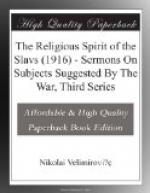Title: The Religious Spirit of the Slavs (1916) Sermons On Subjects Suggested By The War, Third Series
Author: Nikolai Velimirovic
Release Date: September 7, 2004 [EBook #13388]
Language: English
Character set encoding: ASCII
*** Start of this project gutenberg EBOOK religious spirit, Slavs ***
Produced by Zoran Stefanovic, Frank van Drogen and Distributed Proofreaders Europe. This file was produced from images generously made available by Project Rastko.
St. Margaret’s, Westminster
Sermons on subjects suggested
by the war
THIRD SERIES
THE RELIGIOUS SPIRIT OF THE SLAVS
THREE LECTURES GIVEN IN LENT, 1916
BY
The Rev. Father Nicolai Velimirovic
Priest of the Serbian Church, and Professor of Theology in the University of Belgrade
I. Slav orthodoxy
II. Slav revolutionary catholicism
III. The religious spirit of
the Slavs
1916
I
SLAV ORTHODOXY
The Holy Synod and Tolstoi.
When Count Tolstoi was excommunicated by the Holy Synod of Russia because “he preached the teachings which are contrary to the Christian faith,” the world was divided in opinion and sympathy into two parts. The partisans of Tolstoi were in the majority in the Western world; those of the Holy Synod in Russia and the Orthodox East. Yet Holy Russia rejected Tolstoi with much more compassion than Western Europe approved of him. It was a human tragedy which is not often repeated in history and was understood only by Russia. The conflict was more stern than appeared on the surface. The problems in question meant not less than the dilemma: either the Christian world was to continue or it must return to the starting point of human history and begin all anew. A little blade of grass in the field said to its green neighbours: “Why do we grow up? It is nonsense and pain. In growing up we grow in complications, which enhance the darkness and pain of our lives. I propose, therefore, to go back into seeds, from which we have grown big and unhappy.”
So spoke one blade of grass to the field. And the field replied: “Although perhaps we are growing in nonsense and pain, still we cannot return, we must grow and go our way in the belief that we are not mistaken.”
That is the simile of Tolstoi and the Holy Synod.
A Circle or a Drama.




